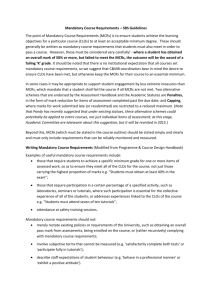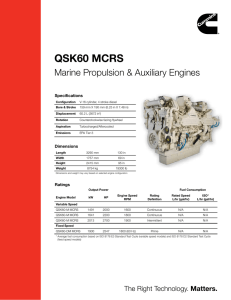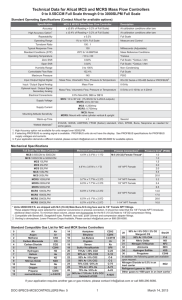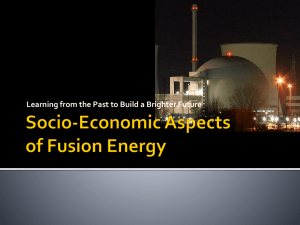benefits of controllable reactors and advantages of magnetic control
advertisement
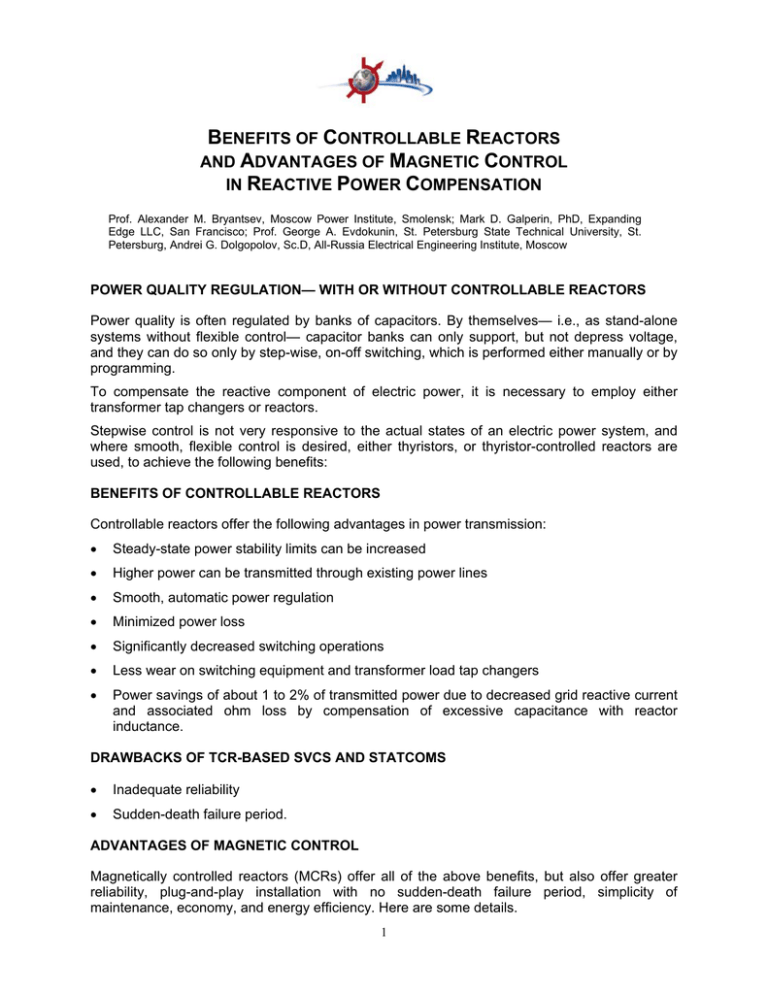
BENEFITS OF CONTROLLABLE REACTORS AND ADVANTAGES OF MAGNETIC CONTROL IN REACTIVE POWER COMPENSATION Prof. Alexander M. Bryantsev, Moscow Power Institute, Smolensk; Mark D. Galperin, PhD, Expanding Edge LLC, San Francisco; Prof. George A. Evdokunin, St. Petersburg State Technical University, St. Petersburg, Andrei G. Dolgopolov, Sc.D, All-Russia Electrical Engineering Institute, Moscow POWER QUALITY REGULATION— WITH OR WITHOUT CONTROLLABLE REACTORS Power quality is often regulated by banks of capacitors. By themselves— i.e., as stand-alone systems without flexible control— capacitor banks can only support, but not depress voltage, and they can do so only by step-wise, on-off switching, which is performed either manually or by programming. To compensate the reactive component of electric power, it is necessary to employ either transformer tap changers or reactors. Stepwise control is not very responsive to the actual states of an electric power system, and where smooth, flexible control is desired, either thyristors, or thyristor-controlled reactors are used, to achieve the following benefits: BENEFITS OF CONTROLLABLE REACTORS Controllable reactors offer the following advantages in power transmission: • Steady-state power stability limits can be increased • Higher power can be transmitted through existing power lines • Smooth, automatic power regulation • Minimized power loss • Significantly decreased switching operations • Less wear on switching equipment and transformer load tap changers • Power savings of about 1 to 2% of transmitted power due to decreased grid reactive current and associated ohm loss by compensation of excessive capacitance with reactor inductance. DRAWBACKS OF TCR-BASED SVCS AND STATCOMS • Inadequate reliability • Sudden-death failure period. ADVANTAGES OF MAGNETIC CONTROL Magnetically controlled reactors (MCRs) offer all of the above benefits, but also offer greater reliability, plug-and-play installation with no sudden-death failure period, simplicity of maintenance, economy, and energy efficiency. Here are some details. 1 Reliability: • Both TCRs and newer STATCOMs use gate turn-off thyristors (GTOs) in their control systems, and both have initial 6-month “sudden death failure periods” (SDFPs) because these GTOs are likely to burn out as much as a couple of times per month when first installed. Unlike TCRs, and even unlike the newer STATCOMs, MCRs do not have this initial SDFP. • With their simple, transformer-like steel core, MCRs have transformer-like reliability, and are more reliable than TCRs or STATCOMs as FACTS controllers. • TCR or STATCOM systems usually contain hundreds of GTOs in their control systems, and one GTO failure in the control system per year for every 100 Mvar of reactive power is considered to be the best achievable rate of failure after an initial SDFP. MCRs have small and relatively inexpensive thyristor control systems, which operate at a low ~1% of the MCR's rated reactive power. Thus MCRs can easily be somewhat overbuilt and hot-tested at the factory to specifications higher than necessary, to ensure proper function after installation. • Also, because of the small size and low rated power and voltage of the MCR control system, spare control systems may be installed, if needed, as hot reserves. • MCRs last longer than TCRs. No MCR has been replaced in more than 20 years of field experience. There are currently more than 140 units in operation. The fact that production has tripled in the past 3 years shows the confidence that utilities have in them after many years of field experience. • The overvoltage limitation for MCRs is 2.3 times rated voltage, vs. 1.8 times for TCRs. Simplicity of Installation and Maintenance • Because of their transformer-like design, MCRs have a transformer-like “plug-and-play” installation, requiring only a couple of weeks of testing, as opposed to months of testing with TCR-SVCs or STATCOMS. • MCRs are as simple to operate and maintain as ordinary transformers. • MCRs are as reliable as transformers. Economy and Energy Efficiency • MCRs cost twice less then TCRs of the same rated parameters. • MCRs require an installation space of about 10 sq. ft per Mvar, vs. 100 sq. ft per Mvar for TCRs with air-core reactors. • Without filters, the current-distortion coefficient of MCRs is about 3%, as against 5.8% for TCRs. Thus fewer filters are required. • At rated reactive power consumption, internal power losses in reactors of greater than 35kV rated voltage are only 0.4% in 180 Mvar MCRs and 0.7% in 32 Mvar MCRs. Compare TCRs of the same rated voltage, whose internal power losses are about 1.1% because they require step-down transformers, which waste additional energy. • MCR standby-mode losses are also lower than those of TCR-based SVCs. WHAT DOES IT MEAN FOR THE BOTTOM LINE? • Typical long-distance transmission results in power losses of about 3%. Controllable reactors reduce transmission losses by about 1/3, depending on network configuration. 2
